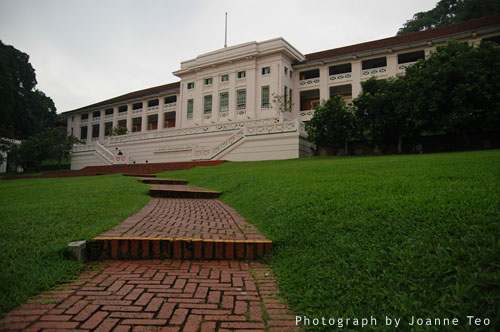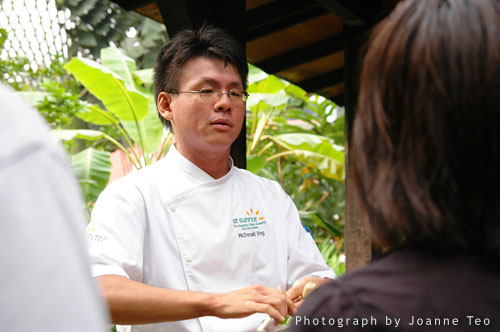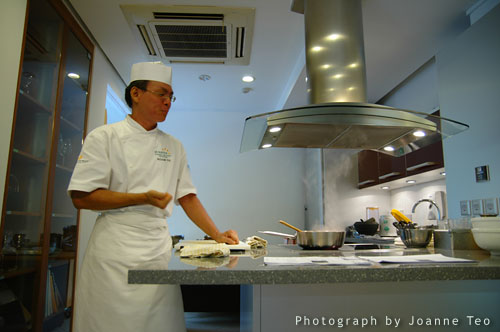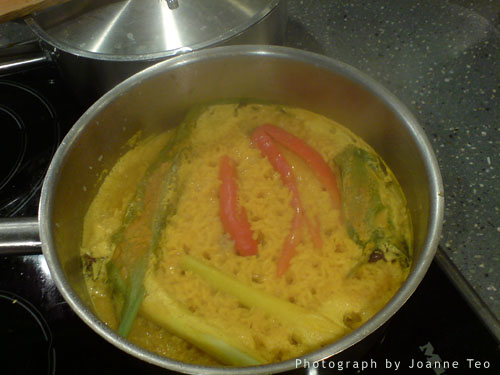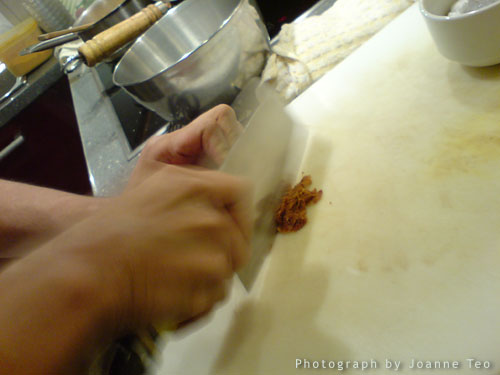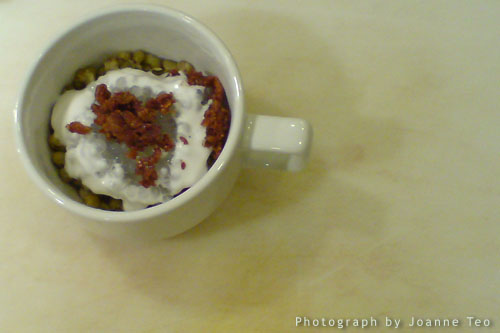Yesterday, I had the opportunity of attending a Spice Garden Walk (Level 1) and Spice Paste Demonstration (Level 2) at at-sunrice.
I’ve always been interested in what was going on there, but the name of the school irritates me, plus the fact that it’s at Fort Canning, which is location-wise, so unfriendly to the pedestrian. Sure, it’s only 10 minutes from either Dhoby Ghaut or City Hall MRT, but somewhere along the way, a real path disappears and let’s not forget there’s a lot of gravity to fight on the way up there.
Still during the time I was on there, I started thinking it would really be interesting to sign up and get fully qualified.
Anyway, it was a good course, starting at 8:30am till 1:30pm. But it really ended only at 3pm.
I had to accompany two Americans who are really a Singaporean and Hong Konger who have lived most of their lives in America. There was a British banker who had just settled into his new posting in Singapore after spending his time in Geneva and New York. The other two were Singaporeans – one was a colleague of the chef.
Okay, I just want to get this out of my system. The unknown Singaporean (ie not the chef’s colleague) and the Singaporean American were damn irritating. This makes 50% of Singaporeans present damn irritating. A pretty high statistic.
Some things that irritated me: When I was pounding away my ingredients with the pestle and motar, one person came up to me and said, “Oh, I’m not doing that, because I know I’m going to use the blender at home.” And another one. When the chef asked if Katong Laksa is a Chinese or Malay dish, Singaporean replied, “It depends, there are so many kinds of laksa.”
I thought it was quite funny that the chef was named McDonald Eng. Okay, Eng is not funny. But McDonald is. I mean funny in the sense that you got McDonald talking about spices. Turns out he was named after a famous footballer. And that he was born in early 1979. McDonald’s arrived in Singapore in the later half of 1979.
Also, we found out that McDonald, always called “Donald” by his parents only discovered he was McDonald when he attended Primary One school. When the teacher called out his name, he laughed along with his classmates that this “McDonald” was named after the fast food chain. He stopped laughing when he found out it was him.
I also discovered that McDonald’s parents owned a laksa stall and that he was an engineer by training, and upon owning some snack shop, discovered he liked cooking a lot before he got started on his new career as chef.
If you really want to know, he speaks with a lisp.
Okay, these are the senseless details that you discover when you hang out with aunties.
Back to the tour.
First you are taken on a spice tour to look at the plants that produce the spices. You get to smell bark, leaves, eat candlenut along the way.
And to prepare you for the mosquitoes, they use a lemongrass brush to give you a cold lemongrass ointment to rub over your arms. Although, by the end of this one hour or so tour, I was starting to scratch.
On the tour, I learnt:
- What is sold off as cinnamon today is probably cassia. Smells and works like cinnamon, but isn’t. Real cinnamon bark is flakey, you wouldn’t be able to look through a tube of cinnamon like a telescope. When I asked the chef where to get real cinnamon for he was hard pressed for an answer. I would’ve said Sri Lanka.
- Candlenut really is used to make candles. (Okay, that’s not new) It is tasteless, has a waxy feel and – this is the new part – is used as a thickener. But don’t use too much, or you’ll get diarrhoea. This information was shared with us only after I popped a whole half of the tasteless nut. Fortunately, nothing happened.
- Indian Borage infused with hot water makes a crappy drink but is great for diarrhoea and tummy aches.
- When you finish a meal on a banana leaf at an Indian restaurant, when you fold the leaf (in half) away from you, you’re telling the host/staff that the food was crap and you’ll never return. If you fold it toward you, it means you really enjoyed the food and will be back again. If you fold it either left or right it means you thought the meal was just okay.
- Coke with peeled and sliced old ginger, boiled and reduced to half the amount and served with a slice of lime makes for a strange tasting cough syrup.
- The Dorset Naga is the hottest chilli in the world and can be bought in Little India. Although according to Wikipedia and Chilli World, the honour goes to the Naga Jolokia. To complicate matters, some sites like The Chileman call the Dorset Naga the Naga Morich. So, who’s up to the challenge?
- If you use henna to dye your hair, add two eggs to the mix to condition and soften your hair. Otherwise, the henna will make it awfully dry.
There’s more stuff I learnt, but my little brain can only remember so much.
So, on to part II of the course.
By this time, I’m pretty hungry, but there’s no snack, just free flow of lemongrass tea and cold water. I have now developed somewhat of a love-hate relationship with lemongrass tea. When I drink it, half of me wants to spit it out, half of me quite enjoys the flavour. I’m not sure why.
Basically, in this part of the course, you’re given five recipes. The chef demos two tough ones, then he goes on to show three easier ones. Then you pair up with someone (six people in a class) and cook the three easier ones. Then you get to eat all five dishes.
The dishes were:
- Nasi Kunyit (Tumeric Rice)
- Beef Rendang (Rich Coconut Beef Stew)
- Sayur Lodeh Kampung (Vegetable dish) *
- Sambal Ayam dan Bunga Kantan (Spicy Chicken with Ginger Flower) *
- Bubur Kacang (Mung Bean Dessert) *
I think this part is nice because you get to use the spices you just saw, smelt, touched.
Unfortunately, the recipes are crap because they’ve been modified for the ang mo palate. You know the deal – no kick, no spice, no frantic visits to the toilet.
Some of the recipes are crap also because they’re just not a good combo.
There were some interesting things I learnt in the process. Like how to cook sago.
How to cook sago
Sago are tapioca flour balls.
Uncooked they’re hard, opague and white.
Cooked, they’re translucent and spongy. If you overcook them, they become soft and mushy.
I love it because they’re fun to eat. Tasteless but fun.
But I find they’re also hard to cook.
So according to the chef, this is how you do it.
Think of the sago ball as a circle with three concentric circles or so.
- Boil up a pot of water. When it’s on a rolling boil, throw in the sago.
- The starch will start to come out. Observe the balls, a layer should start to go translucent.
- Now take out the sago, pour out the water.
- Bring a new batch of water to a rolling boil.
- Repeat the process three to four times for mini balls. Up to seven to eight times for larger balls. Each step will further cook each layer of the ball.
There are some things that I didn’t like about the course, like the room where we were learning had a photocopier and was really too small for six people to cook. When I was pounding the chilli and spices, I kept watching how the photocopier was being splattered red.
There are some questions where I think I didn’t get a satisfactory answer.
Does it make a difference if you heat up oil in a cold pan or pour in oil into a hot pan?
Chef: “No”.
My head: “I think it does.”
When he was making Tumeric Rice (Nasi Kunyit), I asked if it made a difference if you fry the rice a little longer before proceeding to boil it.
Chef: “No, I don’t think so. In commercial kitchen, it doesn’t matter.”
My head: “Yes is does. This is the difference between home cooked and commercially prepared food. Of course I’ve tasted really crap home cooking too. But that’s more because the person making it is just a crap cook.”
Okay, that’s all I can remember. Plus, suddenly I feel very pressured into checking e-mail. I’ve neglected it for three days now.
19th Aug 2007: Updating with photos from my mobile phone. (It’s quite bad to talk about food and not show any of it, right?)
Slicing up Gula Melaka:
The dessert fully assembled:


